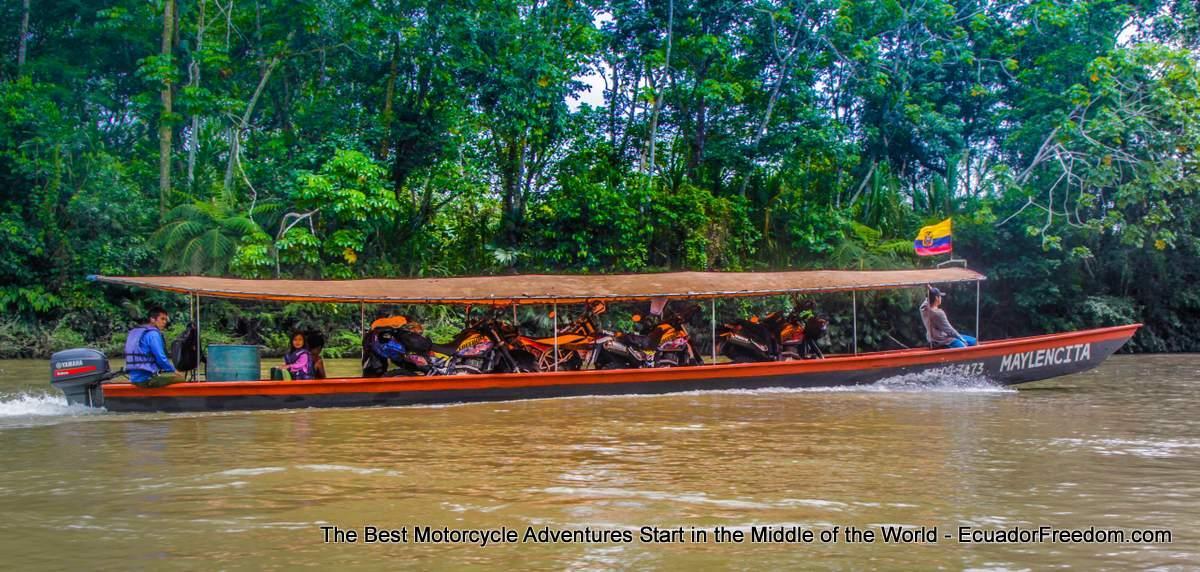Food in Ecuador
|
Cooking good food takes time, as well. In Ecuador, preparing good food is time-intensive. A typical Ecuadorian meal involves soup or stews to start. Making good nutritional soup takes time to bring out the flavors and nutrition in every spoonful. Juices are always made fresh - not from frozen or concentrates. It means you are getting the complete nutrition in every meal, which helps you be ready for a full day of motorcycle riding!
You can visit some of Ecuador's best producers and growers of cacao beans and coffee plantations and enjoy the taste of coffee and chocolate in its purest state. |
A Motorcyclist's Guide to Eating on the Coast of Ecuador
For motorcycle adventure riders, one of the great pleasures of riding Ecuador’s Pacific coast is the opportunity to discover the region's unique cuisine. From Esmeraldas in the north to the port city of Guayaquil in the south, one can sample dishes with exotic names such as Comida encocada, tonga, and cazuela de verde. A source of pride among the population, many of these savory meals also have a unique story about how they came to be. 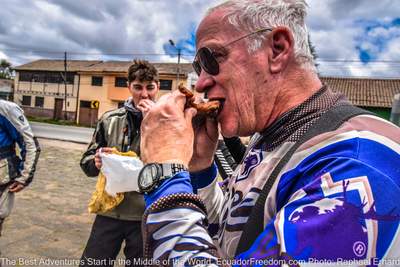
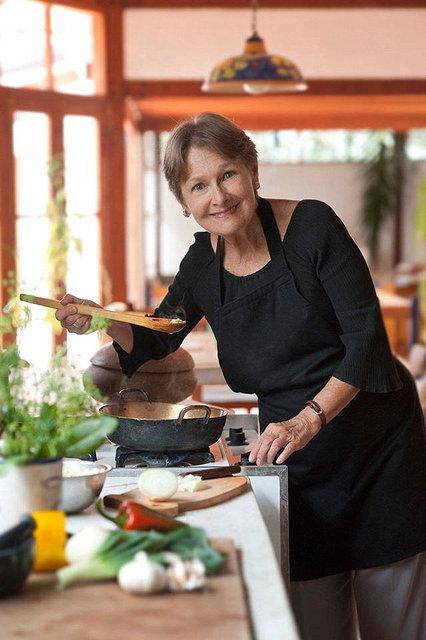 Recently, Ecuador Freedom Bike Rental spoke with Michelle O. Fried, author of the authoritative Ecuadorean cookbook, Comidas del Ecuador and founder ofFUEGOS, a non-profit dedicated to preserving culinary traditions on the coast by training locals for careers as professional chefs. We asked her to talk about what is distinct about cuisine along Ecuador’s coast and what someone on a motorcycle or 4x4 adventure should try when traveling there.
Recently, Ecuador Freedom Bike Rental spoke with Michelle O. Fried, author of the authoritative Ecuadorean cookbook, Comidas del Ecuador and founder ofFUEGOS, a non-profit dedicated to preserving culinary traditions on the coast by training locals for careers as professional chefs. We asked her to talk about what is distinct about cuisine along Ecuador’s coast and what someone on a motorcycle or 4x4 adventure should try when traveling there.
She believes the coastal flavors of the Afro-Ecuadorian community of Esmeraldas are some of the best. With its proximity to the ocean, the locals have long had natural expertise with seafood, and they know that it should be only lightly grilled, steamed, or fried for optimal taste and texture.
Besides, they flavor the fresh seafood by stewing it in coconut milk, a tradition known as “encocado.” Coconut milk is high in fat and is extracted from the hard flesh of a ripe coconut after being grated with the shell of a black conch (unique to Ecuador and, unfortunately, at risk of extinction).
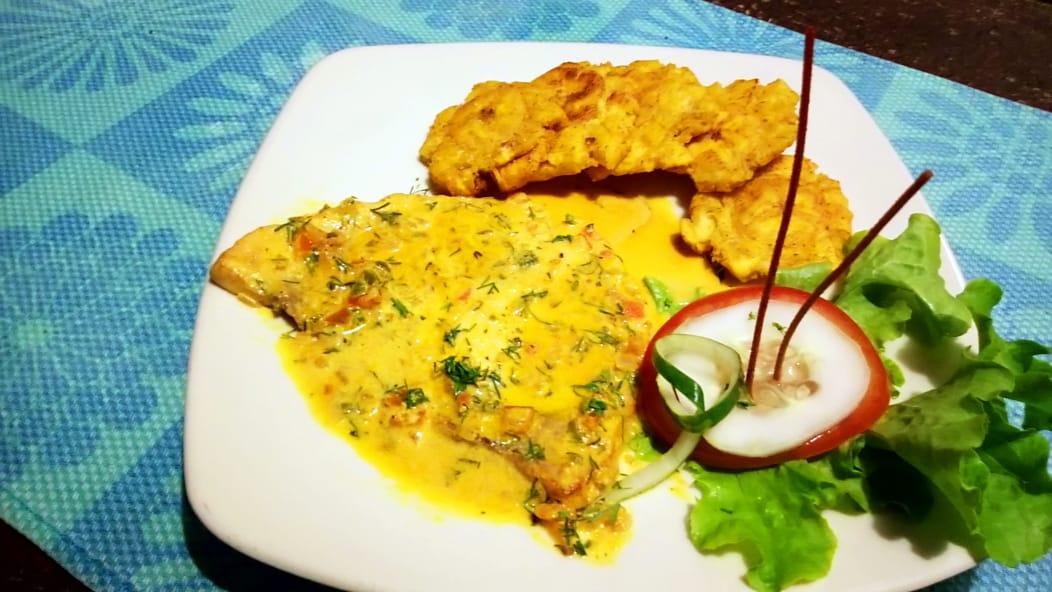 An iconic treat originating in the region, the cocada, also uses coconut as its primary ingredient. A compound of shredded coconut, milk, cane sugar, and cooked over firewood, these very ping-pong balls-sized sweets are very chewy and popular throughout Ecuador. They make a great snack to tuck away in your tank bag or glove compartment, as long as you keep them in a plastic bag. They are very sticky!
An iconic treat originating in the region, the cocada, also uses coconut as its primary ingredient. A compound of shredded coconut, milk, cane sugar, and cooked over firewood, these very ping-pong balls-sized sweets are very chewy and popular throughout Ecuador. They make a great snack to tuck away in your tank bag or glove compartment, as long as you keep them in a plastic bag. They are very sticky!
As you ride further south, you will notice that in communities such as Portoviejo, peanut fat begins to overtake coconut fat as the prime source of flavor and creaminess in the local cuisine. In Manabí province, meals are often cooked in a large clay pot known as the “horno Manaba.”
Often, a peanut soup, which also serves as a sauce, is served along with a roasted purple sweet potato known as camote or the root vegetable known as the yuca. Yuca is almost always fried and is commonly a side dish throughout Ecuador. Still, it is often used to make delicious bread, which will melt in your mouth. You can get the best fresh yuca bread from the vendors selling it in plain, brown paper bags at the speed bumps in the town of Puerto Nuevo, a town you'll cross  through on the way to the coast from Quito.
through on the way to the coast from Quito.
Ground peanuts are also a principal ingredient in a typical local condiment known as salprieta, made of an equal amount of ground, toasted corn blended with oregano, coriander, pepper, salt, and sometimes salt onion, or garlic. “It’s something you can put in anything,” she explains, “soup, eggs, rice.”
In the Manabí province, in cities such as Portoviejo, Manta, and Chone, one of the most popular (and portable) meals is the tonga (also known as a pandao). Wrapped in steamed palm leaves, like a tamale, it offers up a few ounces of rice, fried plantain (a variation of the banana species, known locally as a maduro, meaning “mature,” since it is commonly cooked at full ripeness), chicken, and peanut sauce.
 The banana palm leaf preserves the heat of a freshly-made tonga more effectively than aluminum foil or plastic wrap. It also provides an ecological advantage – one can open the leaf directly on a table, where it can function as an organic “plate.” According to the cookbook author, Michelle Fried, these leaves more effectively preserve and enhance flavor.
The banana palm leaf preserves the heat of a freshly-made tonga more effectively than aluminum foil or plastic wrap. It also provides an ecological advantage – one can open the leaf directly on a table, where it can function as an organic “plate.” According to the cookbook author, Michelle Fried, these leaves more effectively preserve and enhance flavor.
The tonga has its origins in the 19th century along Ecuador’s coast, when much of the region was still a jungle and rich with rubber tree plants. Native women prepared these portable meals for their men before leaving for a long, hard day of labor in sweltering heat harvesting latex.
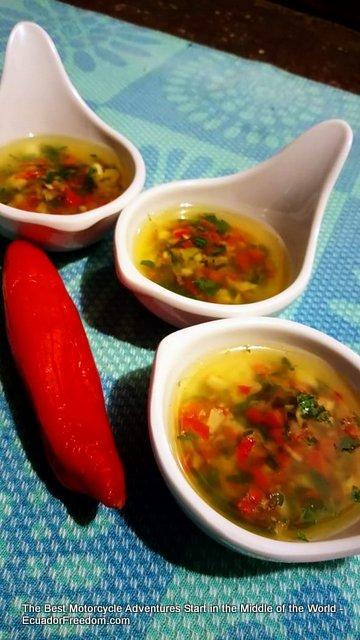 Around Ecuador, you will find a small sauce bowl on every table called aji (pronounced "ah-hee") made from various combinations of tree tomatoes, pearl onions, salt, vinegar, lemon, and chile peppers. Each region proudly serves its variation of the recipe using local ingredients, and the color and texture of the sauce will change as you ride through the country. For people who like their meals extra spicy, Manabí provides a unique aji made from chili peppers and banana vinegar - the smaller the pepper, the hotter the sauce.
Around Ecuador, you will find a small sauce bowl on every table called aji (pronounced "ah-hee") made from various combinations of tree tomatoes, pearl onions, salt, vinegar, lemon, and chile peppers. Each region proudly serves its variation of the recipe using local ingredients, and the color and texture of the sauce will change as you ride through the country. For people who like their meals extra spicy, Manabí provides a unique aji made from chili peppers and banana vinegar - the smaller the pepper, the hotter the sauce.
A native stew (known as “menestra” in Spanish) is often prepared with lentils, lima, or fava beans, usually fresh from the produce markets, instead of dry beans. Whereas in the Andean sierra's cities, a typical stew only features legumes; on the coast, they are cooked up with diced servings of a local squash known as the zapallo.
Zapallo is also prepared with olive oil - a tradition native to this area - resulting from a fluke of history. In the latter part of the 19th century, the port city, Bahia de Caraquez, served as the principal exportation point in Ecuador for tagua, a hard, white nut used in Italy to make buttons for suits and dresses. This resulted in a corresponding importation of European goods, including olive oil, which has remained a core ingredient in the local stew ever since.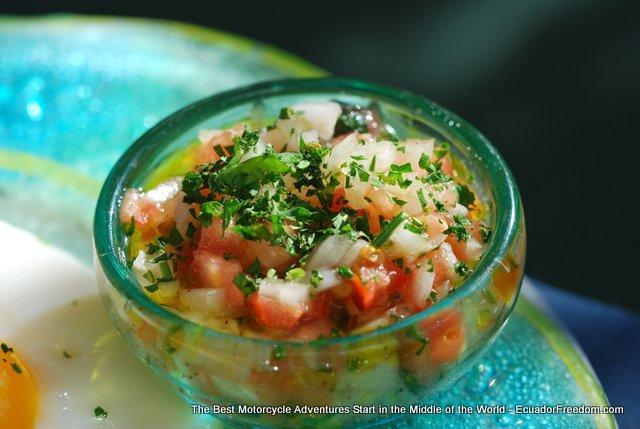
Meals in Manabí are also often prepared with large amounts of onion, celery, and garlic, especially in the city of Manta. “The other thing that gives their food so much flavor,” says Michelle Fried, “is that the moment they serve a ceviche, soup, or stew, they put fresh herbs on top, making their dishes rich in vitamins and minerals.” Families and professional cooks often grow their own herbs, and they are always chopped immediately before serving.
 As for local beverages, instead of lemonade, one can sample a sweet drink made of plantain vinegar, water, and raw cane sugar. Or you can try a local alcoholic brew known as chicha de maiz, made from fig leaf and yellow corn. Drinking right out of a fresh, chilled coconut is also an excellent refreshment for a motorcycle ride on the coast.
As for local beverages, instead of lemonade, one can sample a sweet drink made of plantain vinegar, water, and raw cane sugar. Or you can try a local alcoholic brew known as chicha de maiz, made from fig leaf and yellow corn. Drinking right out of a fresh, chilled coconut is also an excellent refreshment for a motorcycle ride on the coast.
The town of Rocafuerte, north of Manta, is famous for its 300-plus dazzling varieties of colorful sweets, often wrapped in equally colorful paper. The core ingredients in most of these confections are milk, flour, sugar, and cinnamon, but variations include dried fruit, roasted nuts, or coconut. There are 146 families in the area dedicated to producing these treats.
Ecuador's cooking on the coast will fuel your body and, more importantly, your mind with the culture and knowledge of the communities of a land that will linger long after your motorcycle adventure.
An Adventure in Eating-Traditional Food of the Ecuadorian Amazon Jungle
 A big part of any motorcycle adventure to the Ecuadorian Amazon basin is the food. It is an exotic place where the geography, the climate, the culture, and the exuberant availability of produce, fish, and spices come together to give food lovers new flavors to savor. The cuisine here is very different, isolated, and away from the Spanish influence that affected the rest of the country’s cuisine.
A big part of any motorcycle adventure to the Ecuadorian Amazon basin is the food. It is an exotic place where the geography, the climate, the culture, and the exuberant availability of produce, fish, and spices come together to give food lovers new flavors to savor. The cuisine here is very different, isolated, and away from the Spanish influence that affected the rest of the country’s cuisine. 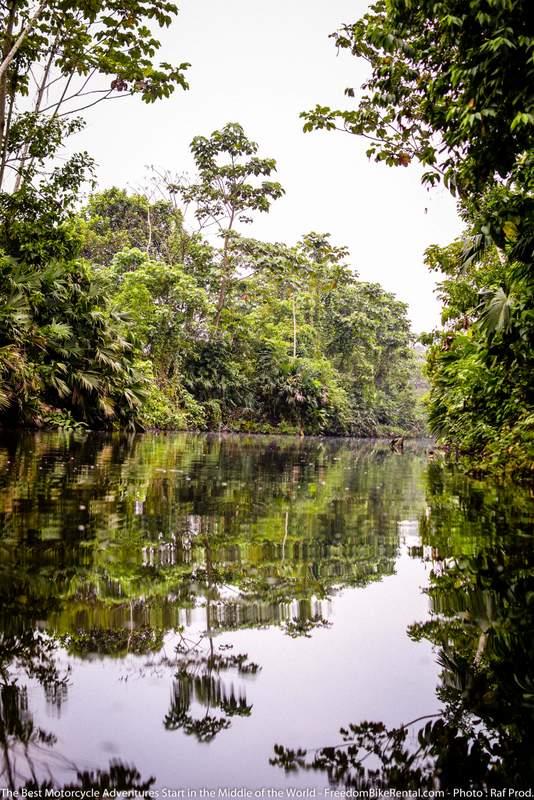
The people of the Amazon have always used what they had locally for their meals. More than 800 kinds of fish, 4000 fruits, and countless edible plants thrive in the Ecuadorian jungle. Wild ginger, garlic, ginger, peanuts, edible ferns, vanilla, amazon cinnamon, 25 kinds of peppers, and starches, including yucca and plantains, grow here.
To understand the Amazon's traditional dishes, you need to understand the people and the area where they live. A few decades ago, there were few roads, and getting back and forth to cities to find supplies readily available in the rest of the country meant an arduous journey.
The AAI Kofan, Secoya, Siona, Waorani, Shuar, Kichwa, and Siekopaai indigenous groups live in the Amazon. They are two tribes that remain in isolation to this day: the Taromenane and the Tagaeri.
Some of these are hunter-gatherers, taking to the forest searching for wild boar, monkeys, and snakes and to the river for turtles and fish. Others, like the Waorani, grow cacao and have increased their quality of life by producing gourmet chocolate that’s now distributed worldwide. Chocolate originated in the jungle and made its way up to Central America after the Mayo-Chinchipe people traded cacao beans with people on the coast.
Different communities have embraced international travelers' interests and created jungle lodges that benefit villages' education and medical needs up and down the Napo River. Keep reading for a handful of traditional dishes from the "Oriente" - what Ecuadorians call the part of their country located in the Amazon basin.
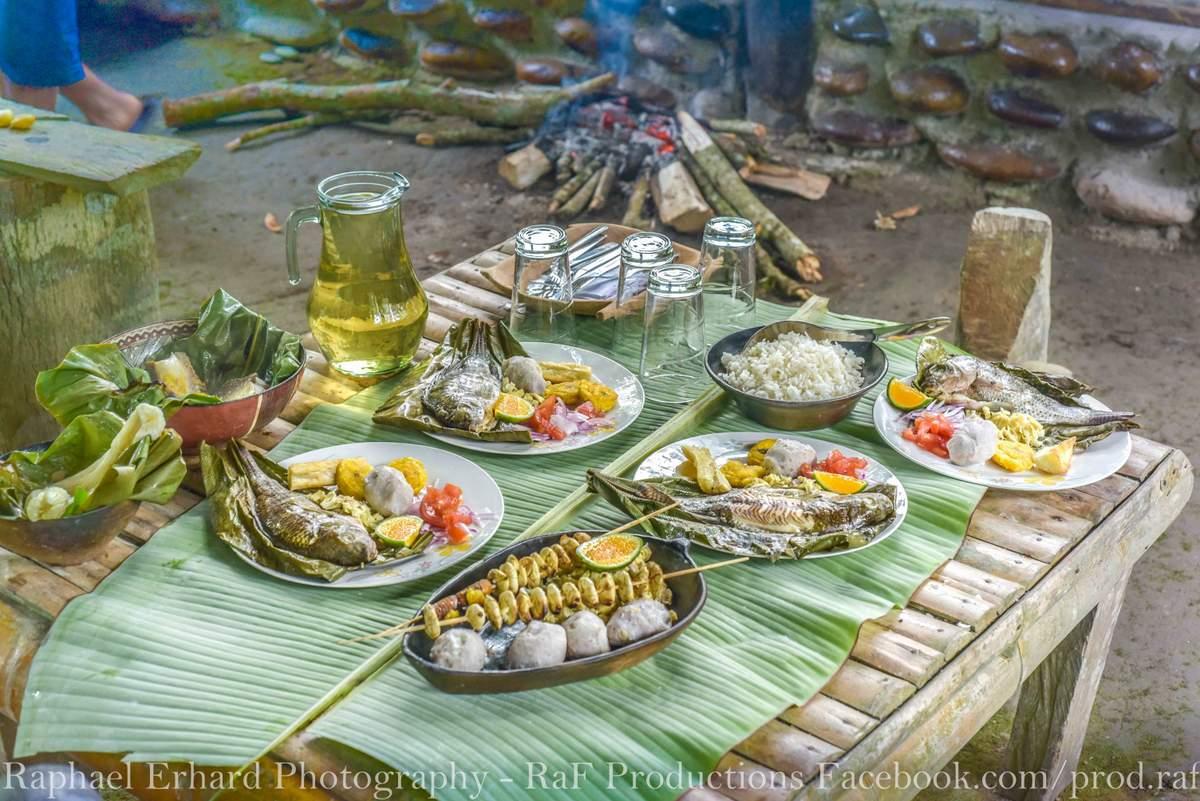
Maito
Maito is tilapia Amazon-style. It is not a native jungle species but rather introduced after being let loose from fish farms, red tilapia, and maito, appearing almost everywhere you look. Markets sell it from stalls, lodges serve it to guests, and a staple of the communities around the jungle.
The fish is seasoned and wrapped in a Bijao leaf and then roasted over hot coals or on a grill. It’s traditionally served with yucca, and the leaf broils the fish in its juices, making it a tender delicacy that is not to be missed.
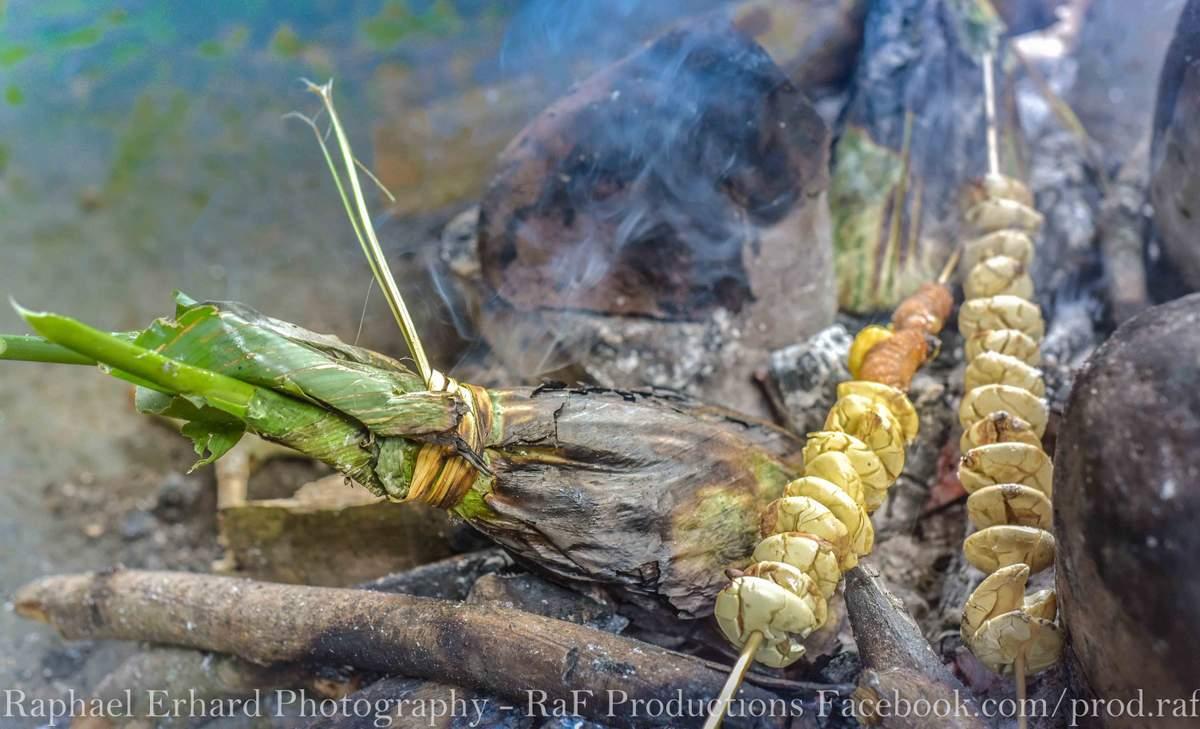
Paiche
Paiche is a freshwater Amazon fish that can grow to 8 Ft. and weigh over a hundred pounds. It has long been a jungle staple, grilled, fried, or baked and served with yucca. It has a mild flavor, and often jungle kitchens do it with ají negro, a specialty hot sauce that each community makes differently-but as a rule, it uses wild peppers and the leftover juices from making yucca bread.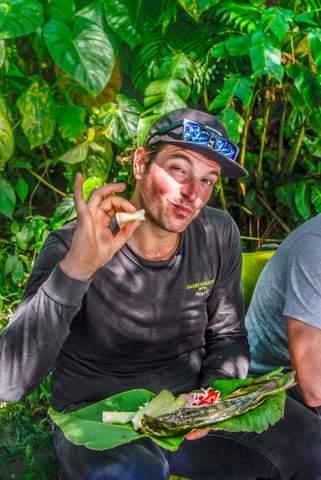
Long overlooked outside of the Amazon, Paiche has made its way into innovative kitchens around the country. Some use it for a new twist on ceviche; others put it in an encocado-a fish stew from the coast-instead of seafood, and it has made appearances on menus in the states and Europe.
Piranha
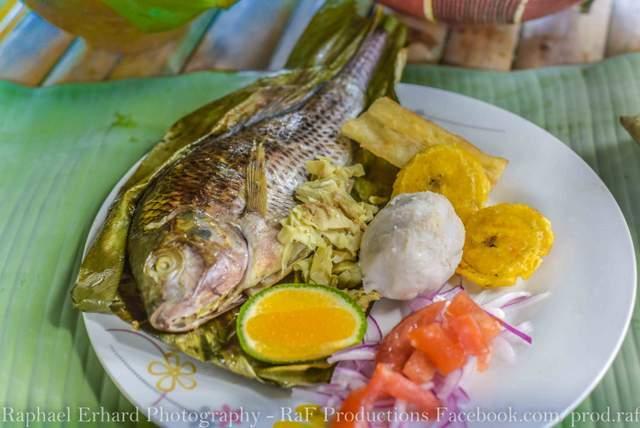 There are three different types of piranha in the Ecuadorian Amazon Basin and are found in abundance in the shallow waters of the region's lagoons, rivers, and tributaries. The small fish are often a lunch dish. Fried and served with various sides, including rice, fried plantains, and salad.
There are three different types of piranha in the Ecuadorian Amazon Basin and are found in abundance in the shallow waters of the region's lagoons, rivers, and tributaries. The small fish are often a lunch dish. Fried and served with various sides, including rice, fried plantains, and salad.
Soups and Stews
Caldo de Bagra
Caldo de Bagra is a robust stew that combines catfish, yucca, tomatoes, pepper, and spices into a meal that feeds the Napo River's families and communities. It is a traditional dish and a staple. Fishermen bring back the day’s catch, and the village elders oversee the preparation, bringing just the right balance of flavor and substance to the table.
Uchumanga
While the Andes have tripe and the coast has encocado, the Amazon combines the two into Uchumanga, a stew made with fish (all of the fish,) sometimes animal intestines, and a burst of spice that hits the right spot. It is the Amazon equivalent of a Ploughman’s Lunch-whatever on hand - it is put in the pot and served to hungry community members.
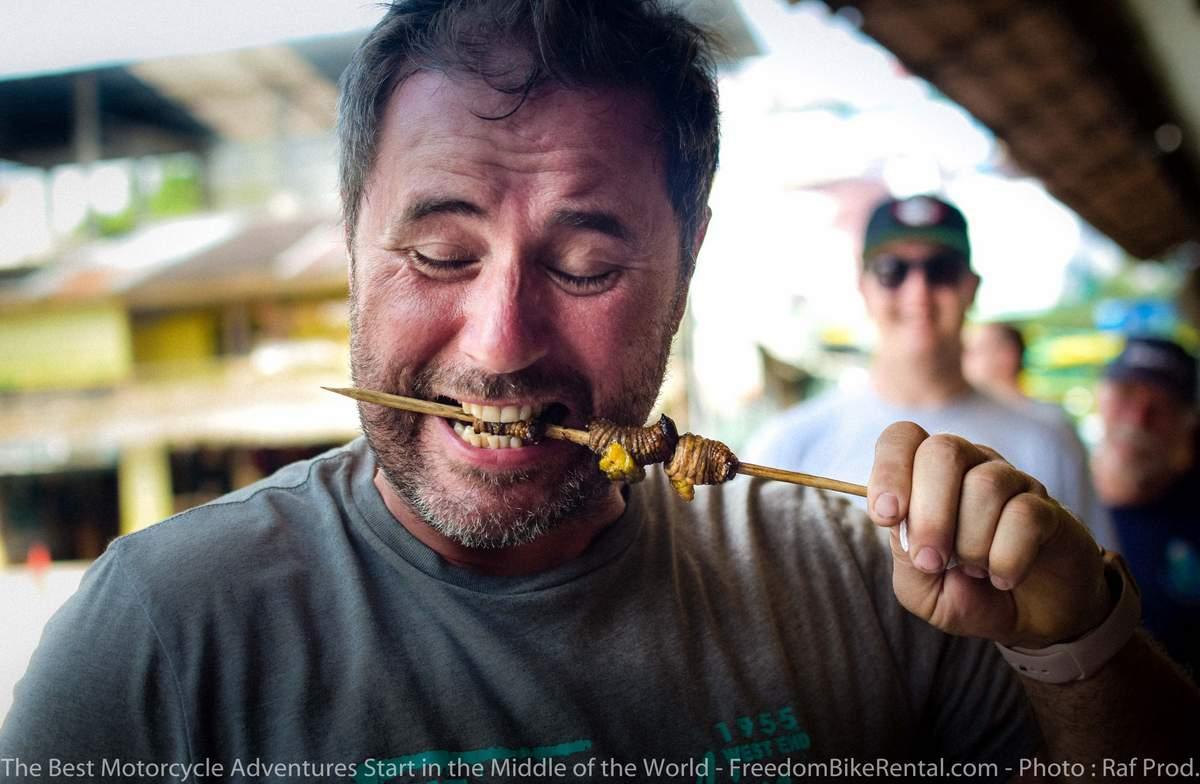
Exotic
Chontacuro or Mayón
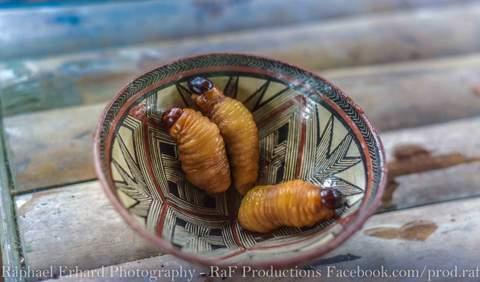 Chontacuros are thumb-sized worms that live in rotting trees until harvested. They are a signature dish of the Amazon-sold on skewers at street stands, used in traditional meals at indigenous events, and even eaten alive. More often than not, they are barbequed over open flames and eaten with fried plantains or yucca.
Chontacuros are thumb-sized worms that live in rotting trees until harvested. They are a signature dish of the Amazon-sold on skewers at street stands, used in traditional meals at indigenous events, and even eaten alive. More often than not, they are barbequed over open flames and eaten with fried plantains or yucca.
Chicha
Chicha is one of the most well-known beverages of the Ecuadorian Amazon. Traditionally it’s made by chewing yucca and spitting it into a bucket to ferment. Saliva helps to break down the tuber and keep the fermenting process moving.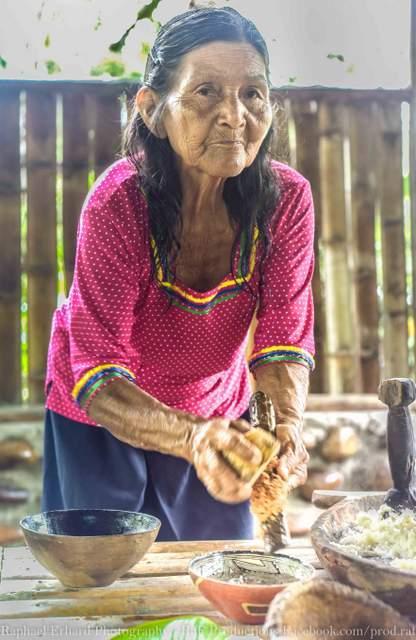
Unless you visit communities deep in the jungle, it is usually made without the saliva at the present. If you go into a Napo community where it is still made the old-fashioned way, be aware that it’s considered disrespectful to refuse the drink.
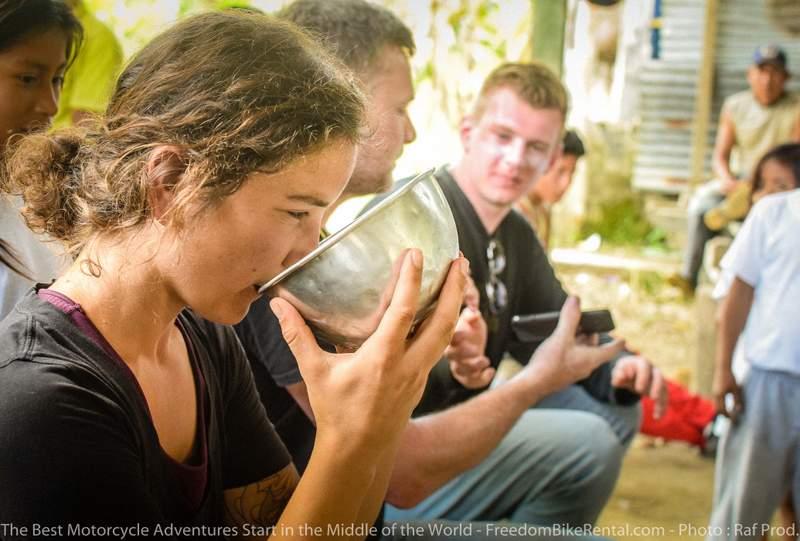 Our High Andes, Deep Amazon Tour takes you to towns and places where the area's culture and community are at center stage alongside the creatures of the wild. The way of life on the river depends on a reliance between the Oriente communities and the environment. The bonds and friendships that develop between travelers and the people who live there go beyond the beaten paths of other parts of the country. One day you might meet someone at a restaurant in one spot, and the next afternoon find that your boat driver is his brother.
Our High Andes, Deep Amazon Tour takes you to towns and places where the area's culture and community are at center stage alongside the creatures of the wild. The way of life on the river depends on a reliance between the Oriente communities and the environment. The bonds and friendships that develop between travelers and the people who live there go beyond the beaten paths of other parts of the country. One day you might meet someone at a restaurant in one spot, and the next afternoon find that your boat driver is his brother.
Contact a team member for more information about our off-the-beaten-path guided and self-guided tours to the Amazon and the other Ecuador regions guided and self-guided tours to the Amazon and the other Ecuador regions, contact a team member.
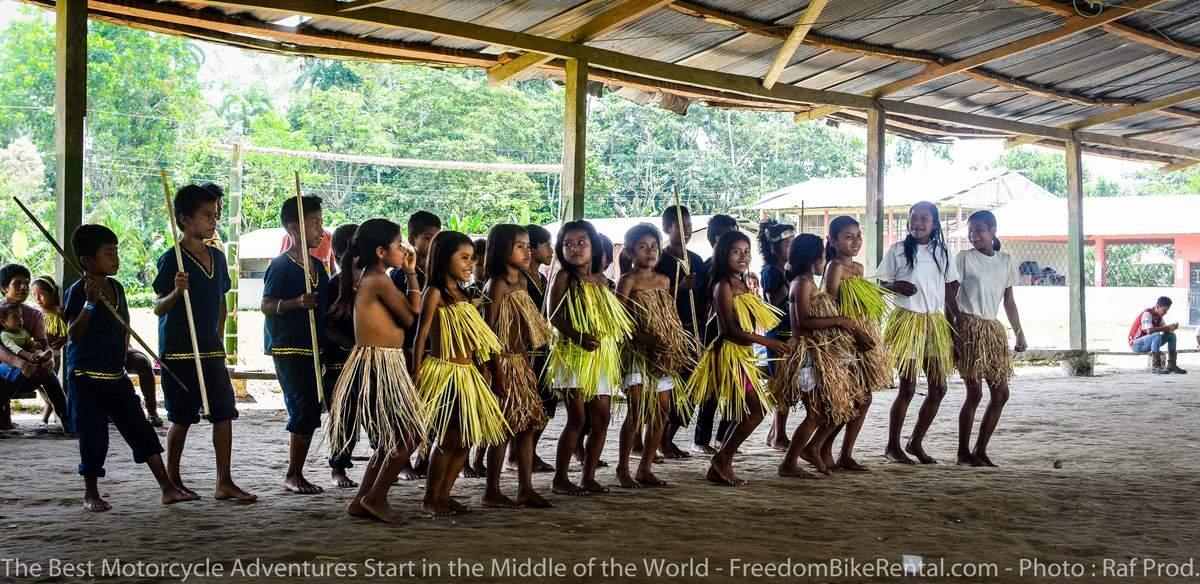
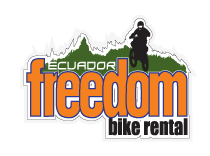

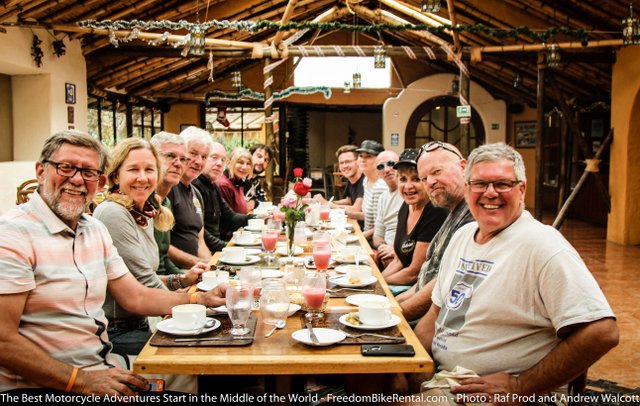 Making good food requires both time and good ingredients. In Ecuador, good ingredients come from healthy, sustainable farming practices that are the norm here. Animals are raised on small, family farms where the animals enjoy a good life (except for one bad day). Free-range chickens, pigs, and cows are raised the old-fashioned way. Vegetables, rice, and potatoes are grown by hand and, in many cases, without heavy farm machinery. Time and care are taken at every step in the process.
Making good food requires both time and good ingredients. In Ecuador, good ingredients come from healthy, sustainable farming practices that are the norm here. Animals are raised on small, family farms where the animals enjoy a good life (except for one bad day). Free-range chickens, pigs, and cows are raised the old-fashioned way. Vegetables, rice, and potatoes are grown by hand and, in many cases, without heavy farm machinery. Time and care are taken at every step in the process.
 If you like coffee or chocolate, Ecuador is the place for you! For centuries, Ecuador has been sending its raw cacao and coffee beans to the best chocolatiers and coffee roasters in Switzerland, Italy, France, and Belgium. However, the Ecuadorians have recently copied the Europeans and "cut out the middle man" to make their chocolates and roast their own coffee. The result? Fresh coffee and chocolate better than you have ever experienced in your life!
If you like coffee or chocolate, Ecuador is the place for you! For centuries, Ecuador has been sending its raw cacao and coffee beans to the best chocolatiers and coffee roasters in Switzerland, Italy, France, and Belgium. However, the Ecuadorians have recently copied the Europeans and "cut out the middle man" to make their chocolates and roast their own coffee. The result? Fresh coffee and chocolate better than you have ever experienced in your life!


